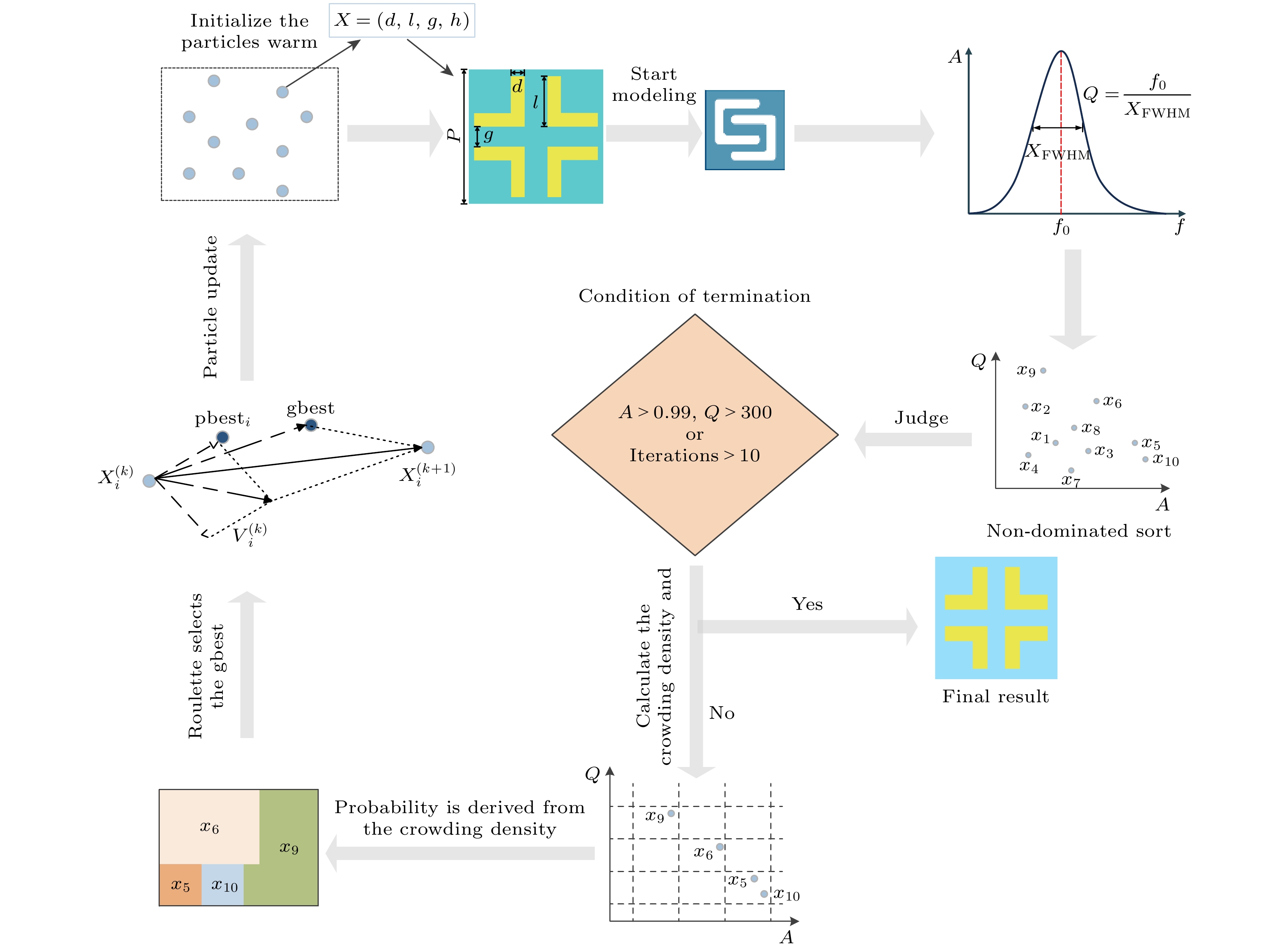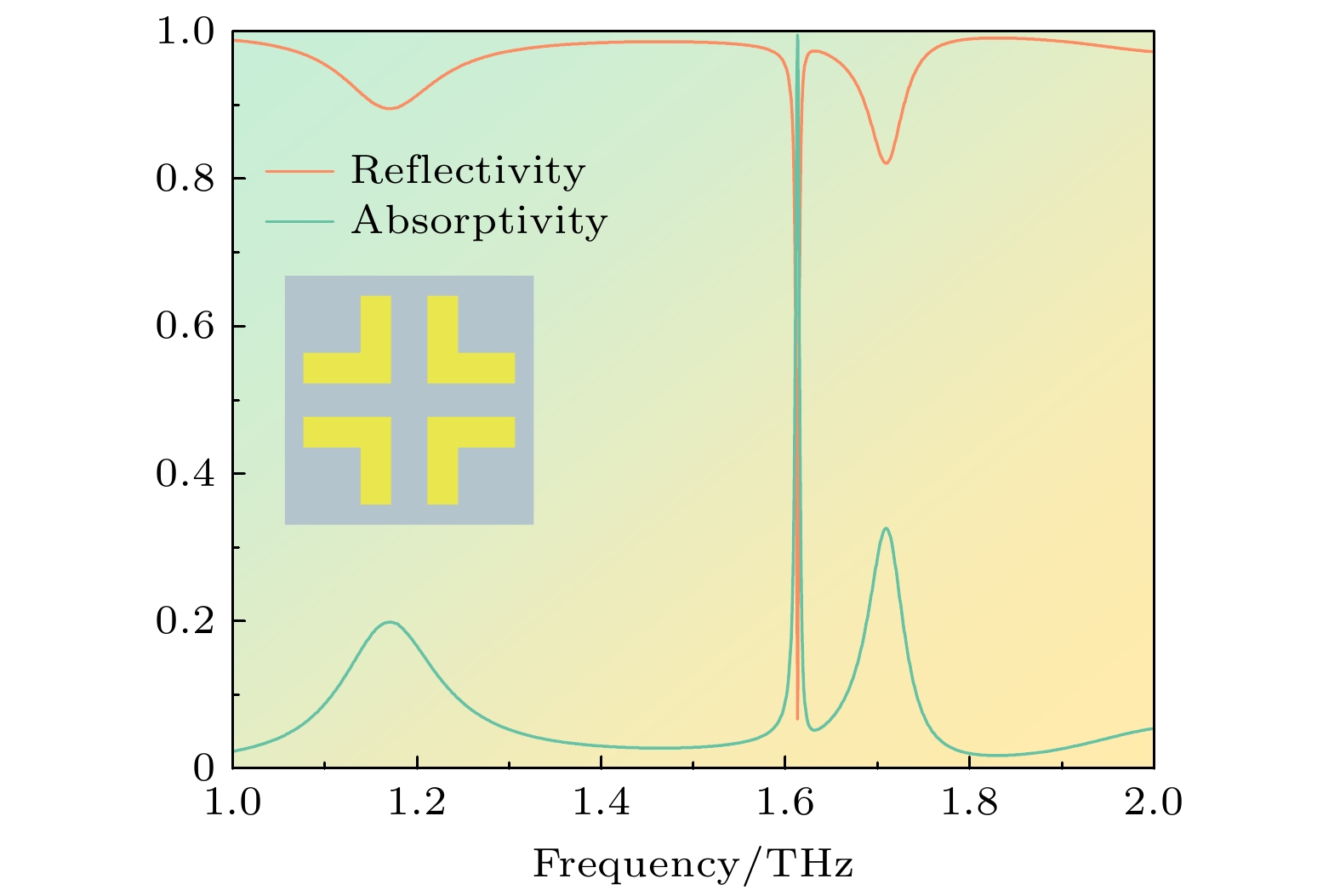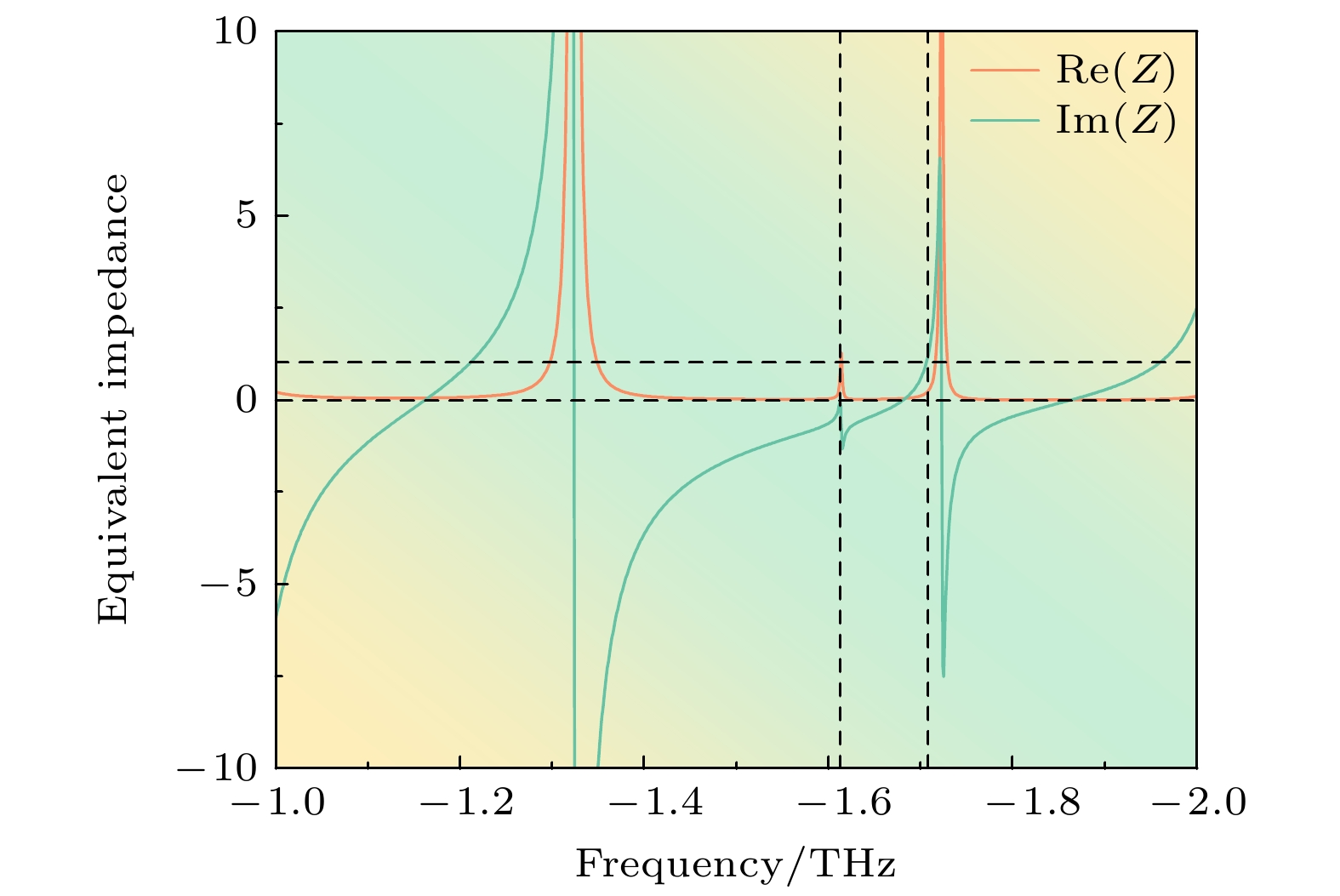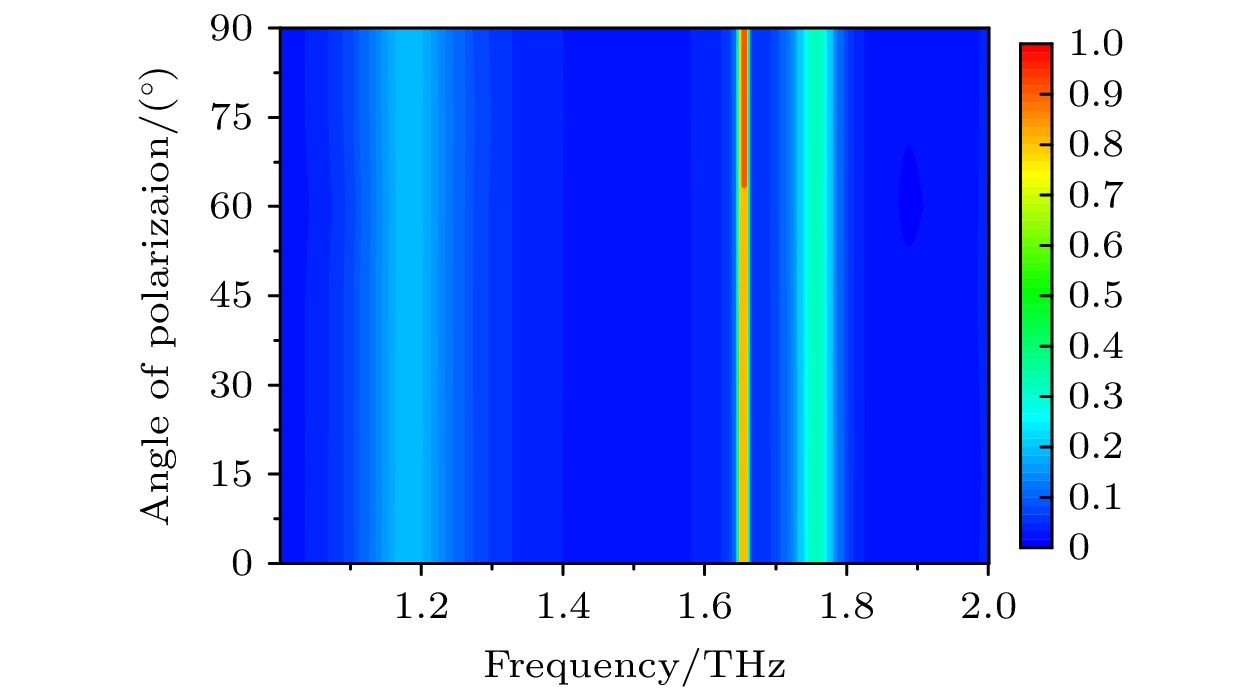-
传统太赫兹超材料吸收器设计需多次试错调整, 十分依赖设计人员的经验, 设计时间成本高、效率低, 而目前基于机器学习的设计方法或需要准备大量样本, 或无法并行优化多个目标. 为解决这一问题, 本文提出一种基于多目标粒子群的几何参数优化方法, 以吸收率和品质因子为设计目标寻找符合要求的结构参数和介质厚度, 并以一个由四个角码型金属组成的中心对称结构的吸收器为例进行优化设计. 仿真结果表明, 多目标粒子群所快速获取的结构几何参数可以同时满足高吸收率和高品质因子两个设计目标, 明显优于粒子群算法. 通过该方法设计的吸收器在1.613 THz的吸收率大于99%, 品质因子为319.72, 其传感灵敏度可达264.5 GHz/RIU. 相比于传统设计方法, 此方法设计出的超材料吸收器可以实现高吸收率、高品质因子和高灵敏度, 为超材料吸收器的设计提供了新的思路, 具有广阔的应用前景.Metamaterials can freely control terahertz waves by designing the geometric shape and direction of the unit structure to obtain the desired electromagnetic characteristics, so they have been widely used in sensing, communication and radar stealth technology. The traditional design of terahertz metamaterial absorber usually requires continuous structural adjustment and a large number of simulations to meet the expected requirements. The process largely relies on the experience of researchers, and the physical modeling and simulation solution process is time-consuming and inefficient, greatly hindering the development of metamaterial absorbers. Therefore, due to its powerful learning ability, deep learning has been used to predict the structural parameters or spectra of metamaterial absorbers. However, when designing a new structure, it is necessary to prepare a large number of training samples again, which is both time-consuming and not universal. Particle swarm optimization algorithm can quickly converge to the optimal solution through the sharing and cooperation of individual information in the group, with no need for prior preparation. Therefore, a method of fast designing terahertz metamaterial absorber is proposed based on multi-objective particle swarm optimization algorithm in this work. Taking a new center symmetric absorber structure composed of four Ls for example, the structure parameters are optimized to achieve rapid and automatic design of metamaterial absorber. The multi-objective particle swarm optimization algorithm takes the absorptivity and quality factor as independent targets to design the structure parameters of the absorber, realizing the dual-objective optimization of the absorber, and overcoming the shortcoming of the multi-objective conflicts that cannot be solved by PSO. When used for refractive index sensing, the optimally-designed absorber achieves perfect absorption at 1.613 THz with a quality factor of 319.72 and a sensing sensitivity of 264.5 GHz/RIU. In addition, the reasons of absorption peaks are analyzed in detail through impedance matching, surface current, and electric field distribution. By studying the polarization characteristics of the absorber, it is found that the absorber is not sensitive to polarization, which is more stable in practical application. In summary, the multi-objective particle swarm optimization algorithm can realize the design according to the requirements, reduce the experience requirement of researchers in the design of metamaterial absorber, thereby improving design efficiency and performance, and has great potential for application in the design of terahertz functional devices.
-
Keywords:
- terahertz metamaterial absorber /
- multi-objective optimization /
- particle swarm optimization /
- parameter optimization
[1] 崔子健, 王玥, 朱冬颖, 岳莉莎, 陈素果 2019 中国激光 46 0614023
 Google Scholar
Google Scholar
Cui Z J, Wang Y, Zhu D Y, Yue L S, Chen S G 2019 Chin. J. Lasers 46 0614023
 Google Scholar
Google Scholar
[2] 金嘉升, 马成举, 张垚, 张跃斌, 鲍士仟, 李咪, 李东明, 刘洺, 刘芊震, 张贻歆 2023 72 084202
 Google Scholar
Google Scholar
Jin J S, Ma J C, Zhang Y, Zhang Y B, Bao S Q, Li M, Li D M, Liu M, Liu Q Z, Zhang Y X 2023 Acta Phys. Sin. 72 084202
 Google Scholar
Google Scholar
[3] Nadège K, Fabrice L, Mathias F, Geoffroy L 2015 Nature 525 77
 Google Scholar
Google Scholar
[4] Meng T H, Hu D, Zhu Q F 2018 Opt. Commun. 415 151
 Google Scholar
Google Scholar
[5] 江晓运 2021 博士学位论文(武汉: 华中科技大学)
Jiang X Y 2021 Ph. D. Dissertation (Wuhan: Huazhong University of Science and Technology
[6] 潘学文, 赵全友, 梁晓琳 2021 光电子·激光 32 680
Pan X W, Zhao Y Q, Liang X L 2021 J. Optoelectron. Laser 32 680
[7] Amirhossein N R, Pejman R 2022 Micro. Nanostruct. 163 107153
 Google Scholar
Google Scholar
[8] Wang J C, Tu S, Chen T 2024 Physica E 155 115829
 Google Scholar
Google Scholar
[9] 涂建军, 马丁 2023 电子学报 51 3262
 Google Scholar
Google Scholar
Tu J J, Ma D 2023 Acta Electron. Sin. 51 3262
 Google Scholar
Google Scholar
[10] Ma W, Cheng F, Liu Y M 2018 ACS Nano 12 6326
 Google Scholar
Google Scholar
[11] Huo Z Y, Zhang P Y, Ge M F, Li J, Tang T T, Shen J, Li C Y 2021 Nanomaterials 11 2672
[12] Ma J, Huang Y J, Pu M B, Xu D, Luo J, Guo Y H, Luo X G 2020 J. Phys. D 53 464002
 Google Scholar
Google Scholar
[13] 谢朝辉, 屈薇薇, 邓琥, 李桂琳, 尚丽平 2023 光学学报 43 1316001
 Google Scholar
Google Scholar
Xie Z H, Qu W W, Deng H, Li G L, Shang L P 2023 Acta Opt. Sin. 43 1316001
 Google Scholar
Google Scholar
[14] 江晓运 2022 博士学位论文(北京: 北京科技大学)
Feng Q 2022 Ph. D. Dissertation (Beijing: University of Science and Technology Beijing
[15] Arora C, Pattnaik S S 2020 Evol. Intell. 14 801
[16] Abolfazl M, Hamid R M, Abbas Z 2023 Photonics Nanostruct. 53 101105
 Google Scholar
Google Scholar
[17] Chen Y, Ding Z X, Zhang M, Li M J, Zhao M, Wang J K 2021 Appl. Opt. 60 9200
 Google Scholar
Google Scholar
[18] 韩丁, 马子寅, 王俊林, 岳莉莎, 王鑫, 刘苏雅拉图 2019 中国激光 49 1714001
Han D, Ma Z Y, Wang J L, Wang X, Liu S Y 2022 Chin. J. Lasers 49 1714001
[19] Coello C A C, Pulido G T, Lechuga M S 2004 IEEE Trans. Evol. Comput. 8 256
 Google Scholar
Google Scholar
[20] Leng R, Ouyang A J, Liu Y M, Yuan L W, Wu Z Y 2020 Int. J. Pattern Recognit. Artif. Intell. 34 2059008
 Google Scholar
Google Scholar
[21] 杨佳蓬, 逯景桐, 张帅, 岳莉莎, 许建春, 毕科 2024 电子元件与材料 43 176
Yang J P, Lu J T, Zhang S, Xu J C, Bi K 2024 Electron. Compon. Mater. 43 176
[22] 葛宏义, 李丽, 蒋玉英, 李广明, 王飞, 吕明, 张元, 李智 2022 71 108701
 Google Scholar
Google Scholar
Ge H Y, Li L, Jiang Y Y, Li G M, Wang F, Lü M, Zhang Y, Li Z 2022 Acta Phys. Sin 71 108701
 Google Scholar
Google Scholar
[23] 曹瑞 2021 硕士学位论文(南京: 南京邮电大学)
Cao R 2021 M. S. Thesis (Nanjing: Nanjing University of Posts and Telecommunications
[24] Lin Q Z, Li J Q, Du Z H, Chen J Y, Zhong M 2015 Eur. J. Oper. Res. 247 732
 Google Scholar
Google Scholar
[25] Zhang J, Cho H, Mago P J, Zhang H G, Yang F B 2019 J. Therm. Sci. 28 1221
 Google Scholar
Google Scholar
[26] Xue B, Zhang M J, Browne W. N 2013 IEEE Trans. Cybern. 43 1656
 Google Scholar
Google Scholar
[27] 吴小刚, 刘宗歧, 田立亭, 丁冬, 杨水丽 2014 电网技术 38 3405
Wu X G, Liu Z Q, Tian L T, Ding D, Yang S L 2014 Power Syst. Technol. 38 3405
[28] 梁泽坤 2022 硕士学位论文(成都: 电子科技大学)
Liang Z K 2022 M. S. Thesis (Chengdu: University of Electronic Science and Technology of China
[29] 谢朝辉 2024 硕士学位论文(绵阳: 西南科技大学)
Xie Z H 2024 M. S. Thesis (Mianyang: Southwest University of Science and Technology
-
图 6 1.613 THz处表面电流和电场分布图 (a) 1.613 THz处有反射底板表面电流; (b)无反射底板表面电流; (c) 1.613 THz处表面电场分布; (d) 1.613 THz处y = 100平面电场分布; (e) 1.613 THz处x = 100平面电场分布
Fig. 6. Surface current and electric field distribution at 1.613 THz: (a) Surface current at 1.613 THz of an absorber with reflective backplate; (b) surface current of the absorber without reflective backplate; (c) surface electric field distribution at 1.613 THz; (d) y = 100 plane electric field distribution at 1.613 THz; (e) x = 100 plane electric field distribution at 1.613 THz.
图 7 不同折射率下主峰和次峰的谐振频率变化量及拟合曲线 (a)不同折射率下的谐振频率变化量; (b)灵敏度拟合曲线
Fig. 7. The variation of resonant frequency of main and secondary resonant peaks under different refractive indices and their fitting curves. (a) The variation of resonant frequency under different refractive indices; (b) the sensitivity fitting curve of the resonant peak.
表 1 参数优化范围
Table 1. Parameter optimization range.
Parameter d l g h Range/μm 10—30 40—85 10—30 10—25 表 2 非支配解集
Table 2. Non-dominant solution set.
g/μm l/μm d/μm h/μm A/% Q f0/THz 1 27 54 24 18 48.87 473.32 1.638 2 17 46 25 22 99.99 248.31 1.818 3 14 68 11 15 96.79 411.07 1.707 4 21 59 21 18 99.96 277.46 1.631 5 25 58 22 19 99.56 319.72 1.613 表 3 不同制造误差对性能的影响
Table 3. Effect of different manufacturing errors on performance.
Parameter g/μm l/μm d/μm h/μm A/% Q f0/THz PA1 1.24% –2.63% 1.65% –3.75% 89.96 394.95 1.63 25.31 56.47 22.36 18.29 PA2 1.43% 2.06% 1.95% –0.86% 92.82 210.75 1.6123 25.36 59.20 22.43 18.84 PA3 2.52% 3.25% –2.98% 3.21% 96.92 248.10 1.5992 25.63 59.88 21.34 19.63 PA4 3.66% 3.72% –2.74% 3.76% 95.22 234.95 1.5970 25.92 60.16 21.4 19.72 表 4 其他设计方法与本文方法所设计的吸收器性能对比
Table 4. Performance comparison of absorbers designed by other design methods and the method presented in this paper.
-
[1] 崔子健, 王玥, 朱冬颖, 岳莉莎, 陈素果 2019 中国激光 46 0614023
 Google Scholar
Google Scholar
Cui Z J, Wang Y, Zhu D Y, Yue L S, Chen S G 2019 Chin. J. Lasers 46 0614023
 Google Scholar
Google Scholar
[2] 金嘉升, 马成举, 张垚, 张跃斌, 鲍士仟, 李咪, 李东明, 刘洺, 刘芊震, 张贻歆 2023 72 084202
 Google Scholar
Google Scholar
Jin J S, Ma J C, Zhang Y, Zhang Y B, Bao S Q, Li M, Li D M, Liu M, Liu Q Z, Zhang Y X 2023 Acta Phys. Sin. 72 084202
 Google Scholar
Google Scholar
[3] Nadège K, Fabrice L, Mathias F, Geoffroy L 2015 Nature 525 77
 Google Scholar
Google Scholar
[4] Meng T H, Hu D, Zhu Q F 2018 Opt. Commun. 415 151
 Google Scholar
Google Scholar
[5] 江晓运 2021 博士学位论文(武汉: 华中科技大学)
Jiang X Y 2021 Ph. D. Dissertation (Wuhan: Huazhong University of Science and Technology
[6] 潘学文, 赵全友, 梁晓琳 2021 光电子·激光 32 680
Pan X W, Zhao Y Q, Liang X L 2021 J. Optoelectron. Laser 32 680
[7] Amirhossein N R, Pejman R 2022 Micro. Nanostruct. 163 107153
 Google Scholar
Google Scholar
[8] Wang J C, Tu S, Chen T 2024 Physica E 155 115829
 Google Scholar
Google Scholar
[9] 涂建军, 马丁 2023 电子学报 51 3262
 Google Scholar
Google Scholar
Tu J J, Ma D 2023 Acta Electron. Sin. 51 3262
 Google Scholar
Google Scholar
[10] Ma W, Cheng F, Liu Y M 2018 ACS Nano 12 6326
 Google Scholar
Google Scholar
[11] Huo Z Y, Zhang P Y, Ge M F, Li J, Tang T T, Shen J, Li C Y 2021 Nanomaterials 11 2672
[12] Ma J, Huang Y J, Pu M B, Xu D, Luo J, Guo Y H, Luo X G 2020 J. Phys. D 53 464002
 Google Scholar
Google Scholar
[13] 谢朝辉, 屈薇薇, 邓琥, 李桂琳, 尚丽平 2023 光学学报 43 1316001
 Google Scholar
Google Scholar
Xie Z H, Qu W W, Deng H, Li G L, Shang L P 2023 Acta Opt. Sin. 43 1316001
 Google Scholar
Google Scholar
[14] 江晓运 2022 博士学位论文(北京: 北京科技大学)
Feng Q 2022 Ph. D. Dissertation (Beijing: University of Science and Technology Beijing
[15] Arora C, Pattnaik S S 2020 Evol. Intell. 14 801
[16] Abolfazl M, Hamid R M, Abbas Z 2023 Photonics Nanostruct. 53 101105
 Google Scholar
Google Scholar
[17] Chen Y, Ding Z X, Zhang M, Li M J, Zhao M, Wang J K 2021 Appl. Opt. 60 9200
 Google Scholar
Google Scholar
[18] 韩丁, 马子寅, 王俊林, 岳莉莎, 王鑫, 刘苏雅拉图 2019 中国激光 49 1714001
Han D, Ma Z Y, Wang J L, Wang X, Liu S Y 2022 Chin. J. Lasers 49 1714001
[19] Coello C A C, Pulido G T, Lechuga M S 2004 IEEE Trans. Evol. Comput. 8 256
 Google Scholar
Google Scholar
[20] Leng R, Ouyang A J, Liu Y M, Yuan L W, Wu Z Y 2020 Int. J. Pattern Recognit. Artif. Intell. 34 2059008
 Google Scholar
Google Scholar
[21] 杨佳蓬, 逯景桐, 张帅, 岳莉莎, 许建春, 毕科 2024 电子元件与材料 43 176
Yang J P, Lu J T, Zhang S, Xu J C, Bi K 2024 Electron. Compon. Mater. 43 176
[22] 葛宏义, 李丽, 蒋玉英, 李广明, 王飞, 吕明, 张元, 李智 2022 71 108701
 Google Scholar
Google Scholar
Ge H Y, Li L, Jiang Y Y, Li G M, Wang F, Lü M, Zhang Y, Li Z 2022 Acta Phys. Sin 71 108701
 Google Scholar
Google Scholar
[23] 曹瑞 2021 硕士学位论文(南京: 南京邮电大学)
Cao R 2021 M. S. Thesis (Nanjing: Nanjing University of Posts and Telecommunications
[24] Lin Q Z, Li J Q, Du Z H, Chen J Y, Zhong M 2015 Eur. J. Oper. Res. 247 732
 Google Scholar
Google Scholar
[25] Zhang J, Cho H, Mago P J, Zhang H G, Yang F B 2019 J. Therm. Sci. 28 1221
 Google Scholar
Google Scholar
[26] Xue B, Zhang M J, Browne W. N 2013 IEEE Trans. Cybern. 43 1656
 Google Scholar
Google Scholar
[27] 吴小刚, 刘宗歧, 田立亭, 丁冬, 杨水丽 2014 电网技术 38 3405
Wu X G, Liu Z Q, Tian L T, Ding D, Yang S L 2014 Power Syst. Technol. 38 3405
[28] 梁泽坤 2022 硕士学位论文(成都: 电子科技大学)
Liang Z K 2022 M. S. Thesis (Chengdu: University of Electronic Science and Technology of China
[29] 谢朝辉 2024 硕士学位论文(绵阳: 西南科技大学)
Xie Z H 2024 M. S. Thesis (Mianyang: Southwest University of Science and Technology
计量
- 文章访问数: 2818
- PDF下载量: 82
- 被引次数: 0













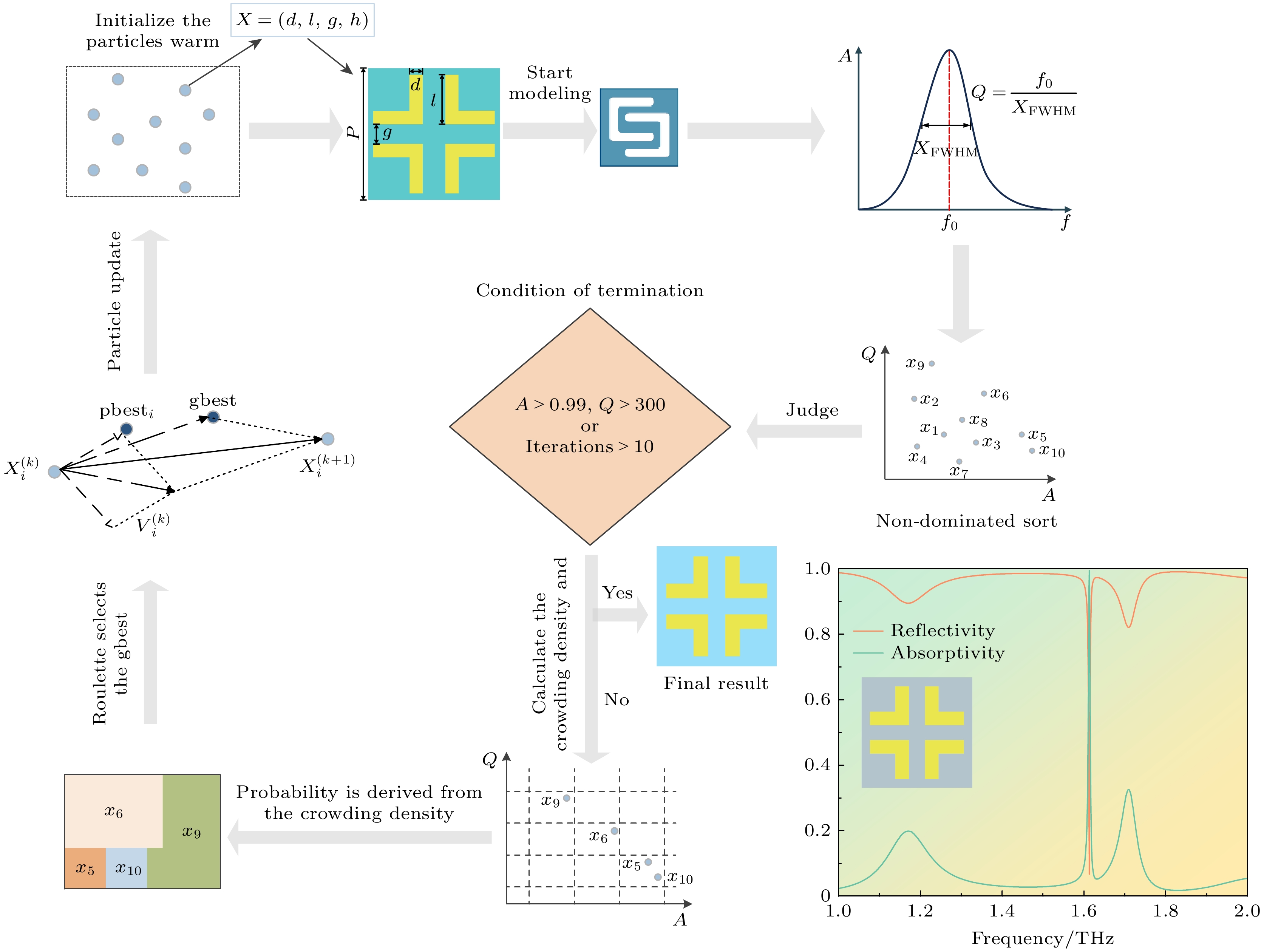

 下载:
下载:

